Travelers keen to explore the beauty of southern California (and a small part of Nevada) have two great options when it comes to spending time in the wilderness of the Mojave Desert: Joshua Tree and Death Valley national parks. But since Death Valley is closest to Las Vegas, and Joshua Tree is closest to Los Angeles, you’ll need to know which park you plan to visit before planning your trip.
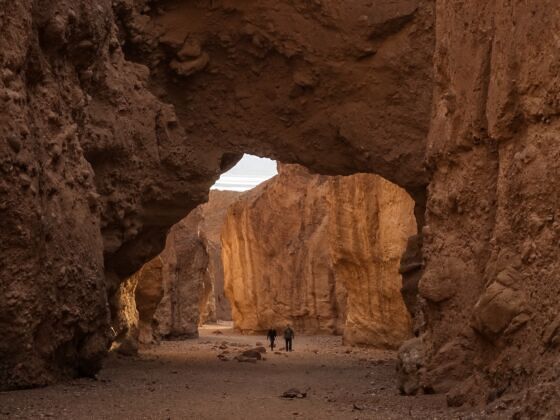

Death Valley Vs. Joshua Tree National Parks: Which Is Best for You?
Joshua Tree is known for its namesake Joshua trees and famous boulders, beckoning photographers, stargazers, hikers, and artists. Death Valley is more about seclusion, remoteness, and the vastness of the desert, with fewer visitors and more extreme adventure options.
If you’re trying to decide between visiting Death Valley vs. Joshua Tree national parks, you’ll want to consider factors like the time of year, what type of hiking trails you prefer, and if you want nearby amenities and hotels, or prefer solo, more self-sufficient travel.
Jump to:
- Environment and nature
- Seasonality and when to go
- Backpacking and backcountry in Death Valley vs. Joshua Tree
- Frontcountry hiking in the parks
- Driving tours and accessible activities
- Other major things to do in each park
- Death Valley vs. Joshua Tree camping
- Hotels in and around Death Valley vs Joshua tree
- Getting to each park
- What kind of traveler will prefer each park?
Nature and environment
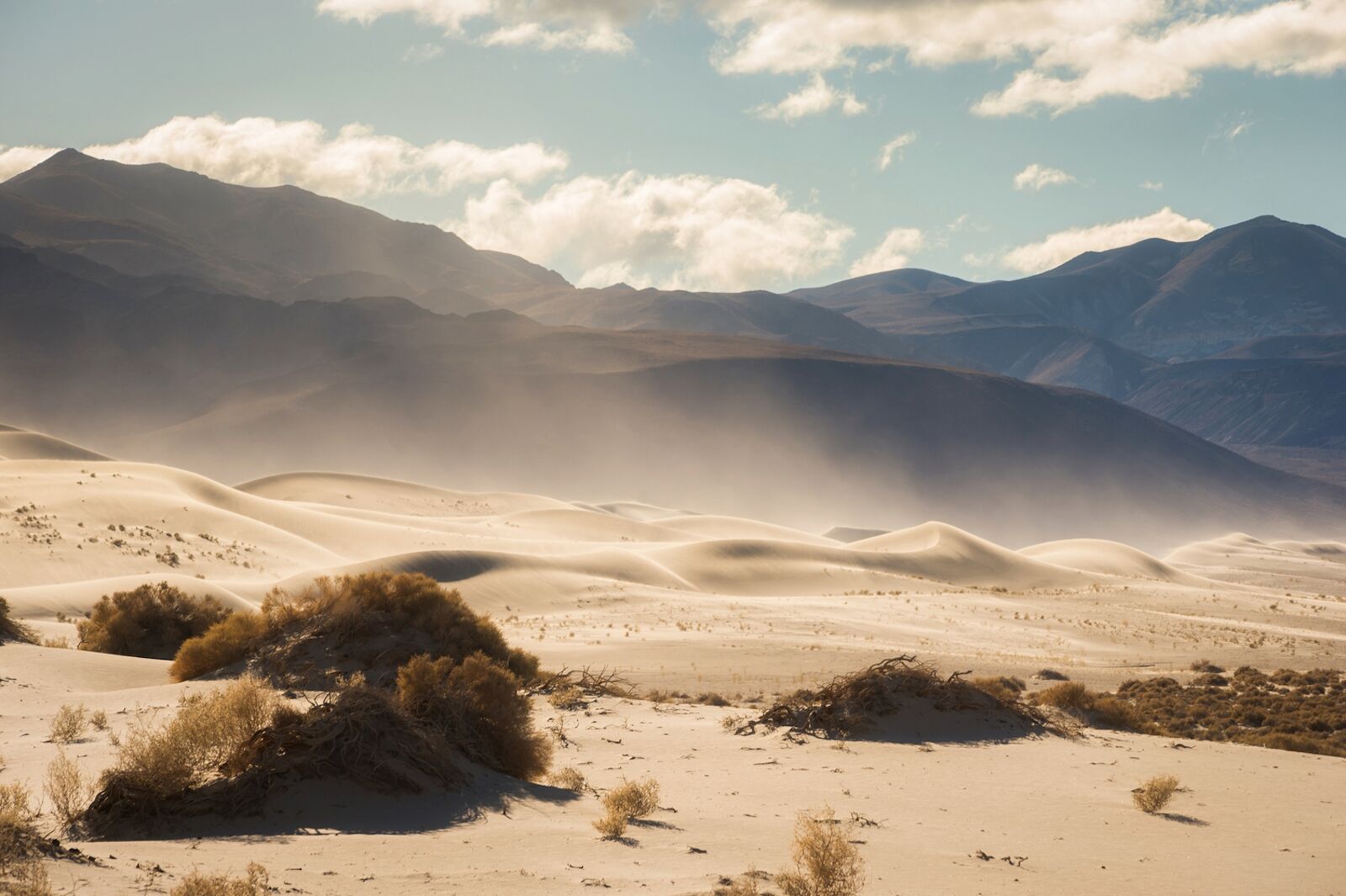
Death Valley’s landscapes have been compared to the moon, Star Wars, and Dune. Photo: NPS/Kurt Moses/Public Domain
Joshua Tree and Death Valley national parks, both in southern California, have a lot in common, as they both cover stunning desert landscapes. But each has its own personality.
Joshua Tree’s beauty lies in its rugged, minimalist appeal. The namesake Joshua trees, with their twisted limbs reaching skyward, seem to tower over spiky yuccas and creosote bushes, dwarfed only by the massive piles of rounded boulders. When comparing Death Valley vs. Joshua Tree, Joshua Tree’s high-desert ecosystem is higher above sea level, allowing for the woodlands and pinyon pine forests. It creates a varied landscape, showcasing the variety of the desert. Most animal species in the park are of a smaller size, like desert reptiles and tortoises, but there’s a very small chance of spotting animals like bighorn sheep or bobcats.
Death Valley, on the other hand, is a land of stark extremes and barrenness, not minimalism. The park’s Badwater Basin is the lowest point in North America at more than 200 feet below sea level, creating a surreal expanse of cracked salt flats. The surrounding mountains are bare, rocky, and dramatic, creating impressive contrasts throughout the park. Death Valley has more canyons and huge sand dunes, and a sense of wilderness, since more than 90 percent of the park is undeveloped.
The plant life in Death Valley is sparser, clinging to survival in the arid conditions, though desert wildflowers have been known to put on spectacular shows right after snowmelts. Wildlife is similarly limited, though the park does have wild burros (which are not native to the landscape).
Seasonality and when to go
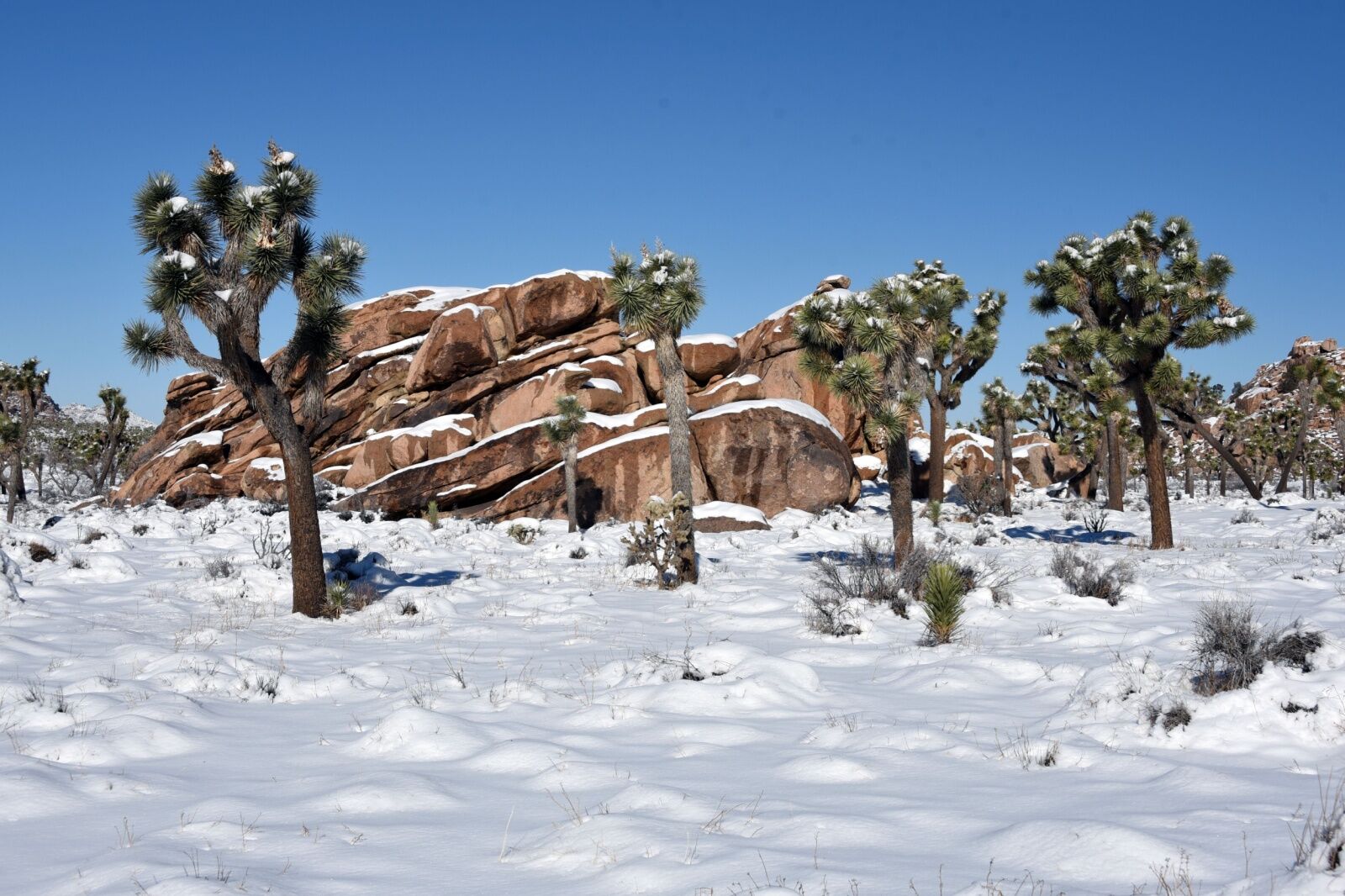
A rare snow covering in Joshua Tree. Photo: dba duplessis/Shutterstock
Joshua Tree and Death Valley, while geographically close, have vastly different weather patterns that impact the best times to visit. If you’re deciding between Death Valley vs. Joshua Tree for a summer trip, pick Joshua Tree. It has more comfortable temperatures in the summer — but that’s not to say it’s cool. Days can get very, very hot in Joshua Tree in the summer, with an average high of about 100 degrees Fahrenheit. You’ll want to take it easy during the middle of the day and do any hiking or activities in the evening or early morning.
The fact that 100 degrees is considered more pleasant should tell you how hot Death Valley can get. Summer (June-August) is brutally hot, with highs often exceeding 120 degrees Fahrenheit. Most outdoor activities are unsafe due to the extreme heat, and many facilities, tours, and campgrounds close entirely.
For both parks, the best times to visit are spring and fall. In Joshua Tree, spring (March-May) and fall (September-November) have highs in the mid-80s F and lows in the 40s, making it ideal for camping and outdoor activities. Winter is also nice, with highs in the 60s Fahrenheit (around 15 degrees Celsius) and occasional nights dipping below freezing. It can very occasionally snow. If you’re planning a spring visit, avoid the weeks during California’s spring breaks, as those dates are usually very crowded.
Death Valley has a similar peak season (mid-October to April), and snow is more likely in the winter, which can close some higher-elevation roads. It’s also at its busiest in the spring during wildflower season. So if solitude is a priority, aim for the shoulder seasons (late spring or early fall) in Joshua Tree, and winter in Death Valley (excluding holidays).
Backpacking and backcountry hiking in Death Valley vs. Joshua Tree
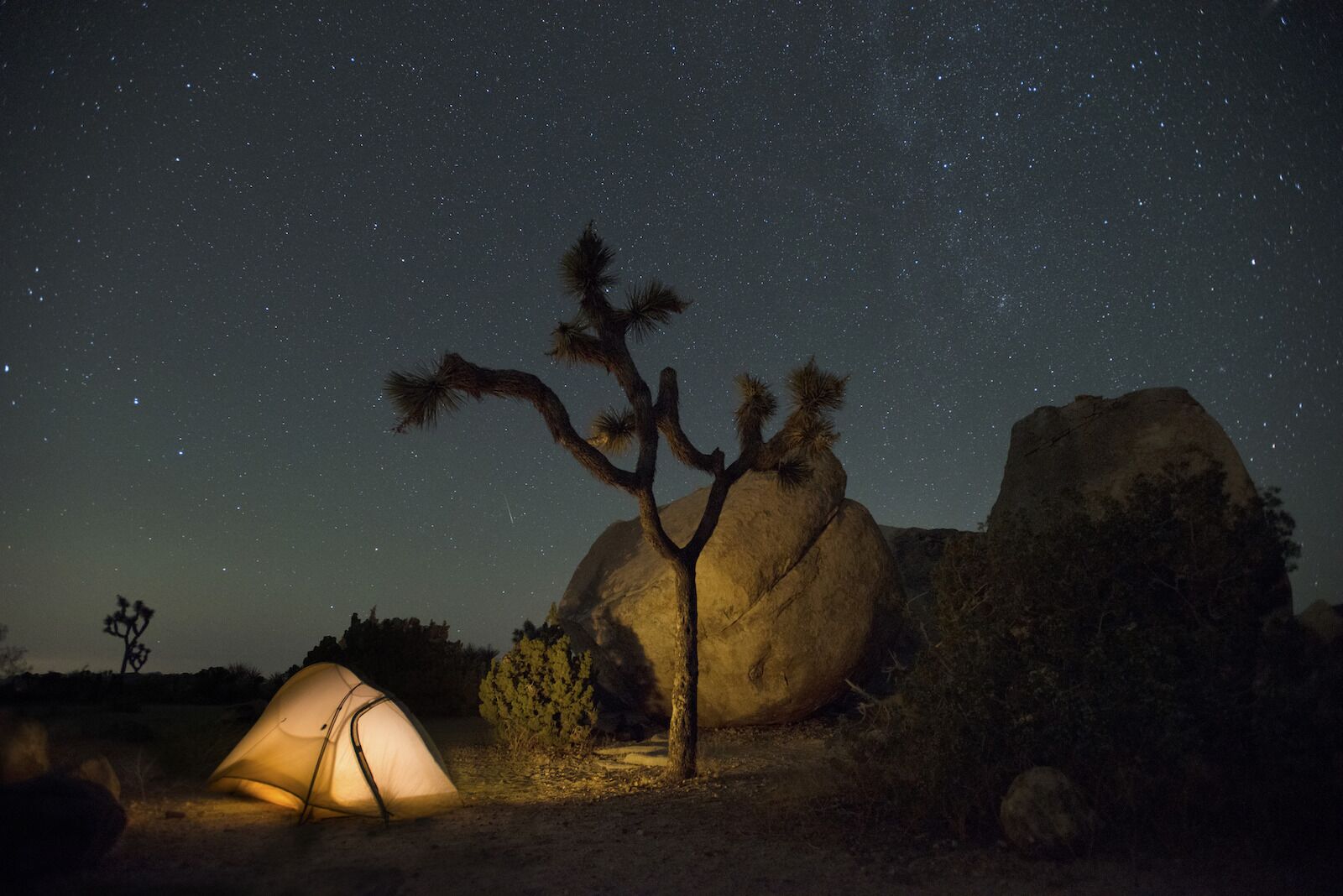
A tent in the backcountry of Joshua Tree National Park. Photo: NPS/Hannah Schwalbe/Public Domain
Backpacking experiences in Joshua Tree and Death Valley national parks differ significantly, though they both cater to desert adventures.
Joshua Tree backcountry hiking and backpacking is not as regulated as other parks. The backcountry is divided into 15 areas, and for most areas, there’s no cap on the number of available backcountry permits (which are required for backcountry camping). Only one of the 15 zones (The Boy Scout Zone) has a fixed number of permits, as you’re only allowed to camp within the designated campground and should reserve it in advance. For all other zones, you can camp anywhere you want, as long as you follow a few basic rules.
The different zones offer a mix of trails and pure wilderness areas. In the latter, you have to chart your own route and may have to scramble and bushwhack in certain areas. If you want a designated trail, consider Eureka Peak in the Black Rock Zone (20 miles, one or two nights), or the 36-mile California Hiking and Riding Trail, which passes through several zones.
In Death Valley, backpacking is even less structured (and less popular). Only one backcountry hike in the park requires a permit: the Cottonwood Canyon Marble Canyon Loop. For all others, permits are suggested to help rangers keep track of backcountry users, but they’re not required. If you get one, do it in person at a visitors center the morning before you start.
Regarding Death Valley vs. Joshua Tree backcountry campgrounds, it’s easy: Death Valley doesn’t have any. Backcountry and multi-day hiking in Death Valley requires a bit more knowledge than in Joshua Tree as there are also very few established trails, so you’ll need to be able to read maps, have solid wayfinding skills, and judge the best routes across a landscape.
In both parks, you can cache water and food, but it’s almost essential in Death Valley, while in Joshua Tree, some trails have water sources. In general, roads are rougher in Death Valley vs. Joshua Tree, and Joshua Tree is better for less-experienced backpackers.
As of Spring 2024, expect rougher-than-normal conditions in Death Valley, as many of the park’s roads and routes were damaged in heavy flooding during the summer of 2023.
Frontcountry and day hiking
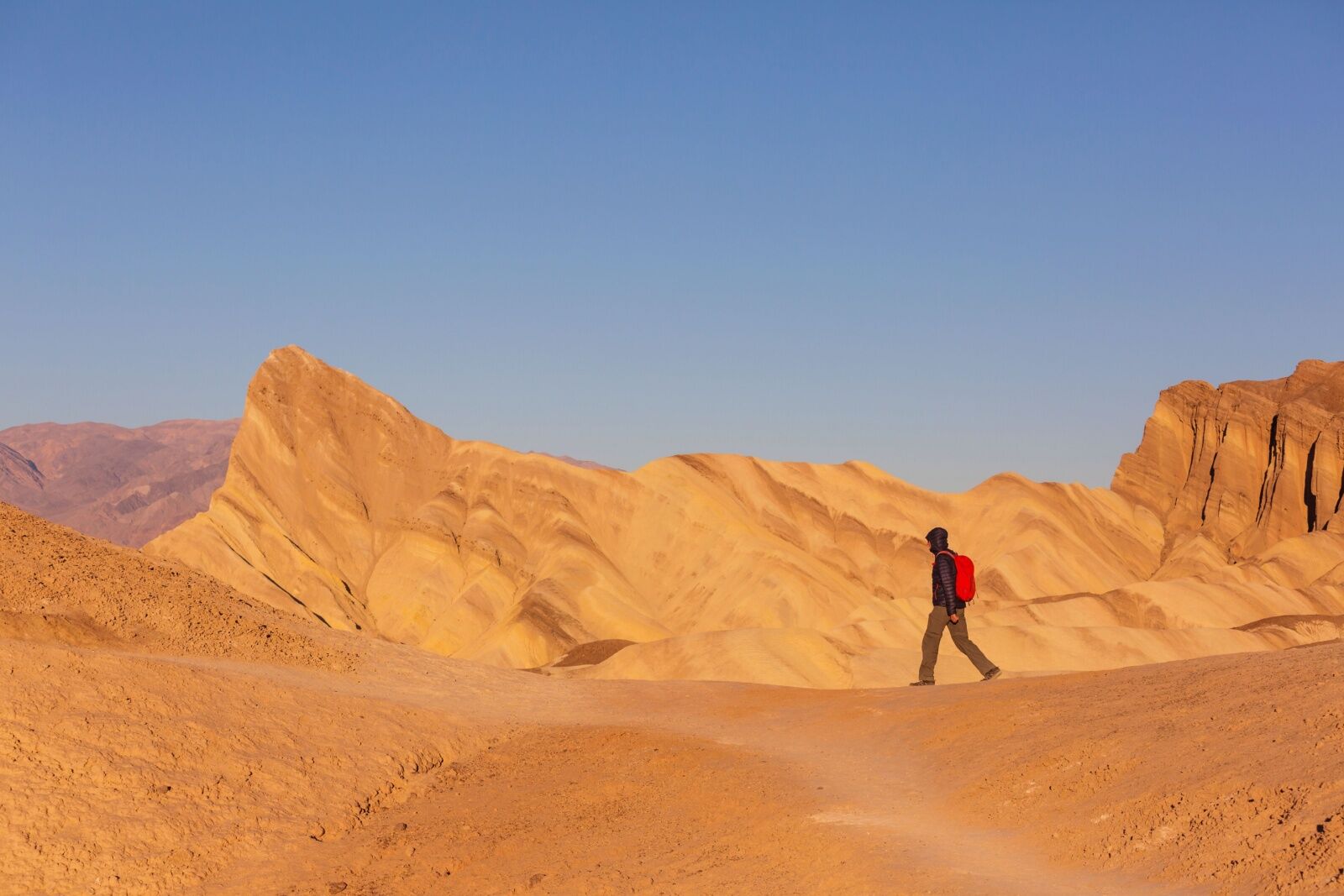
Hikers on the Zabriskie Point trail in Death Valley National Park. Galyna Andrushko/Shutterstock
It’d be easy to think hiking in Death Valley vs. Joshua Tree national parks would be very similar, but despite both being desert landscapes, the experiences are fairly distinct. Joshua Tree hikes are all about rugged rock formations, stark desert plains, and getting close to the iconic Joshua trees. The elevation varies from 3,000 to 5,000 feet, offering panoramic vistas and a more moderate desert climate.
Death Valley throws a different kind of punch. It’s the hottest, driest place in North America, with sculpted canyons, vast salt flats, and colorful rock formations. Hiking trails lead through eroded badlands and past sand dunes, and because it’s below sea level, the temperatures can push into scorching.
Joshua Tree caters to a wider range of hiking abilities, with many trails under one mile with minimal elevation gain. It’s very easy to walk to iconic sites like Jumbo Rocks and Skull Rock, but there are still longer hikes available, like the Willow Trail and the Lost Horse Loop. However, the majority of trails fall in the beginner and intermediate range.
Death Valley’s hiking options are generally considered more challenging due to the harsh environment. Popular choices include Badwater Basin (the lowest point in North America), and Zabriskie Point for stunning panoramic views. The Golden Canyon Trail offers a colorful canyon experience, while hikers seeking a challenge can tackle the Telescope Peak Trail, the park’s highest point. Half the park’s trails are considered moderate, though they have more elevation gain and rougher terrain than the ones in Joshua Tree. Trails are generally less marked and harder to follow on Death Valley vs. Joshua Tree trails.
Driving tours and accessible activities
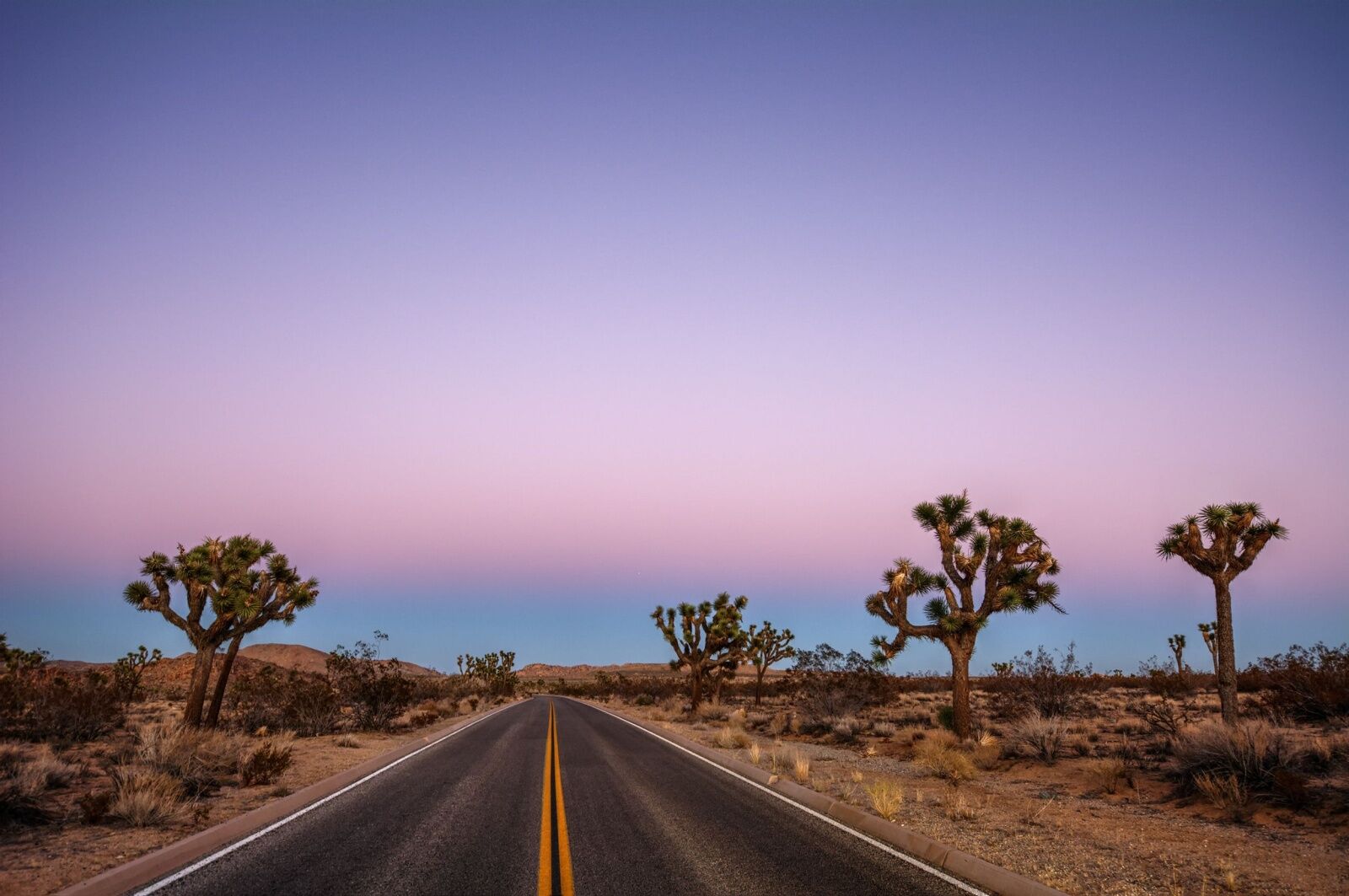
Joshua Tree has more paved and easy-to-drive roads. Photo: West Coast Scapes/Shutterstock
Exploring Joshua Tree and Death Valley national parks can be done via scenic drives and accessible activities, but the landscapes shape the experience. When it comes to driving in Death Valley vs. Joshua Tree, Joshua Tree offers easier self-guided drives. You can get maps for self-guided driving tours from park visitor centers, and popular options include Pinto Basin Road through Joshua tree forests, and Keys View Road, with views of the Coachella Valley.
There are also lots of drivable backcountry roads (also popular with gravel bikers). Lots of companies offer driving tours within the park, including Red Jeep Tours, Joshua Tree Excursions, and Adventure Hummer, among others.
In terms of access, all visitor centers and restrooms are ADA-accessible, as are a few trails. The park is currently working to create more assets for visitors with hearing or vision concerns.
In general, at Death Valley, accessible options are more limited compared to Joshua Tree. The park’s vastness is best explored by car along Badwater Road, which takes visitors past iconic sights with accessible parking and short, paved paths.
Both parks offer accessible ranger programs, lectures, history presentations, and more, as well as audio tours via the NPS App. Just look for the schedule in the park newspaper (usually handed to guests at the gates). At Death Valley, you can request an ASL interpreter for any program by emailing the park in advance. However, much of the park was built before modern ADA standards were developed, and most of it is still primitive wilderness, so it doesn’t have as many accessible areas as parks like Yosemite. But it does have a helpful website that lists the accessibility offerings of every site and amenity in the park.
Other major recreational draws
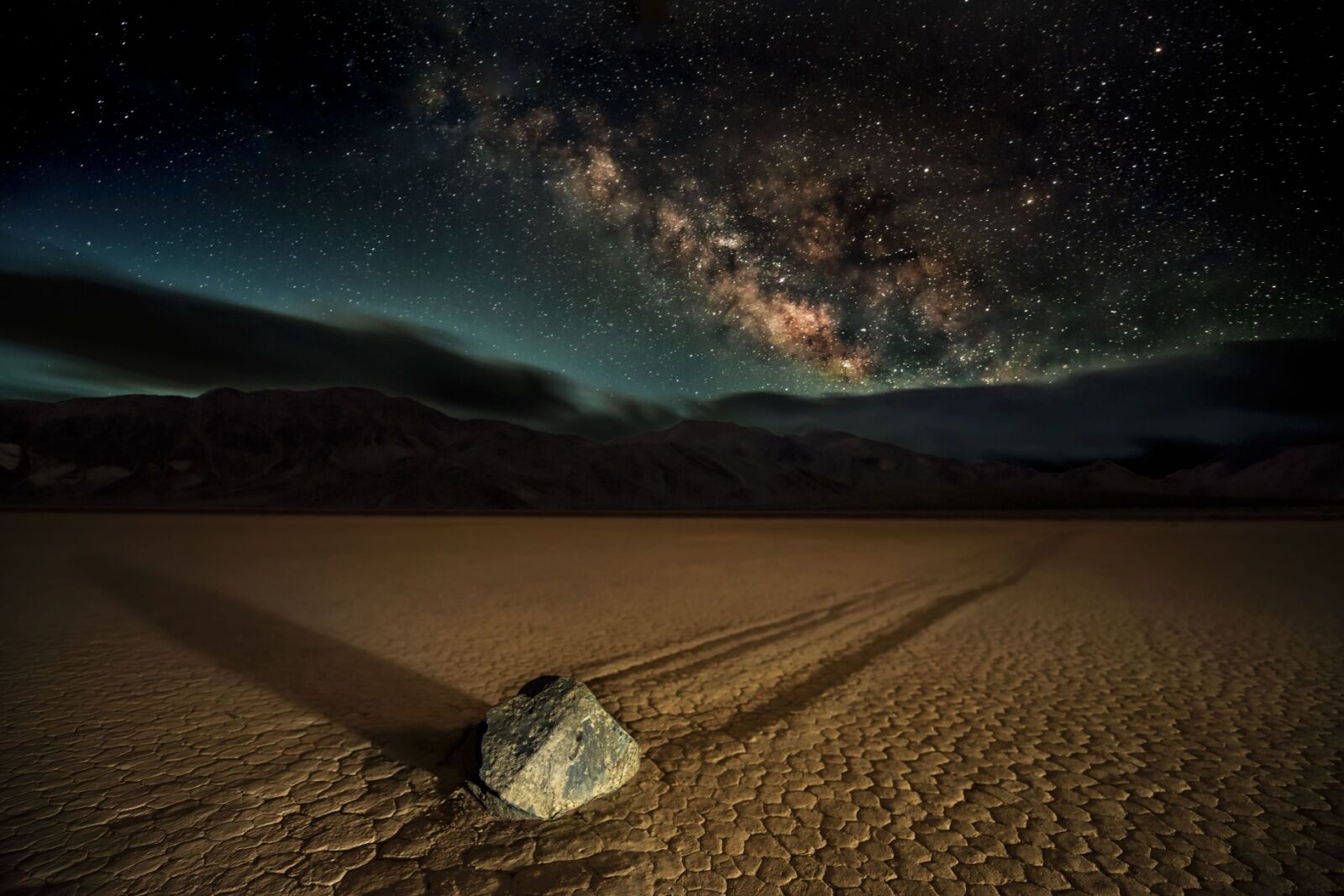
Night sky in Death Valley National Park. Photo: Jeff Stamer/Shutterstock
Joshua Tree and Death Valley national parks offer distinct experiences beyond traditional hiking and camping. Both are also excellent for mountain biking, with bikes allowed on all backcountry roads in both Joshua Tree and Death Valley.
Joshua Tree provides a wider range of activities that cater to creative and athletic pursuits. The park itself offers ranger-led programs on topics like desert ecology, stargazing, and rock climbing history, and private companies in nearby towns like Palm Springs and Twentynine Palms offer everything from tours and art classes to guided rock climbing, horseback rides, or yoga. You’ll find multiple companies offering all types of activities.
Death Valley has fewer guided options and activities and focuses more on experiencing the stark beauty and geological wonders of the desert. However, it also has ranger programs on the park’s history, its role in Native American cultures, and its mining past.
Of course, there’s one activity that shines at both parks, literally: stargazing. You don’t have to give up epic views of the night sky when deciding between Death Valley vs. Joshua Tree. Joshua Tree stargazing is world-class. It’s an official dark sky park, hosts a dark sky festival, and has many area tour operators offering private stargazing sessions in the park. Many area Airbnbs also have dedicated stargazing roofs, though laying on a blanket in the desert works just fine, too.
But don’t fret if you’re headed to Death Valley: it’s also a dark sky park. However, stargazing as an activity/industry isn’t as developed, so you’ll find fewer guided offerings. But as long as you have a stargazing app, and stop by a visitor center to get guidance on the best locations, you’re just as likely to see shooting stars and the Milky Way as you are in Joshua Tree. Death Valley also has a stargazing festival, and it’s even part of Nevada’s first astrotourism driving route.
Camping in Joshua Tree and Death Valley

Mesquite Springs is a high-elevation campground, giving it more pleasant temperatures during summer. Photo: NPS/Kurt Moses/Public Domain
There are no hotels inside Joshua Tree National Park. However, five campgrounds in the park take reservations (Black Rock, Cottonwood, Indian Cove, Jumbo Rocks, and Ryan). Jumbo Rocks is the biggest and probably the most popular, and Black Rock and Cottonwood are the most developed. There’s no water at Indian Cove, Jumbo Rocks, or Ryan, so carry plenty before entering the park.
Indian Cove and Black Rock are closest to the northern entrances, and Cottonwood is closest to the southern entrance. You can make reservations up to six months in advance on Recreation.gov. All fill up pretty quickly for weekends between October and April/May, but if you keep an eye on the reservation page, you can usually find midweek reservations.
The park also has three first-come, first-served campgrounds: Belle, Hidden Valley, and White Tank (only Hidden Valley is open in the summer). The best chance of getting a first-come, first-served site is to arrive early in the morning. If you have plenty of time, you can drive between the campgrounds later in the day to look for a spot, but leave yourself enough time to drive out of the park and find a good BLM primitive camping spot in case the park is entirely full. Joshua Tree has a handy map of places you can camp outside the park, clearly designating what areas are off-limits.
None of the first-come, first-served campgrounds have water, so again, bring plenty.
Camping in Death Valley is usually a little easier to swing. It has seven developed campgrounds, and only one takes reservations (Furnace Creek Campground). And even then, it’s only during the winter you need a reservation; it’s first-come, first-served outside of the mid-October to mid-April window. Fees and amenities vary. The park advises that the Sunset Campground almost always has availability, even in winter. The park also has five primitive campgrounds with no amenities, all of which are first-come, first-served, and require a vehicle with high clearance to reach.
If you visit in the summer, be prepared for extreme heat and try to get one of the higher-elevation campgrounds, like Mesquite Spring or Wild Rose.
Hotels in and around Death Valley and Joshua Tree
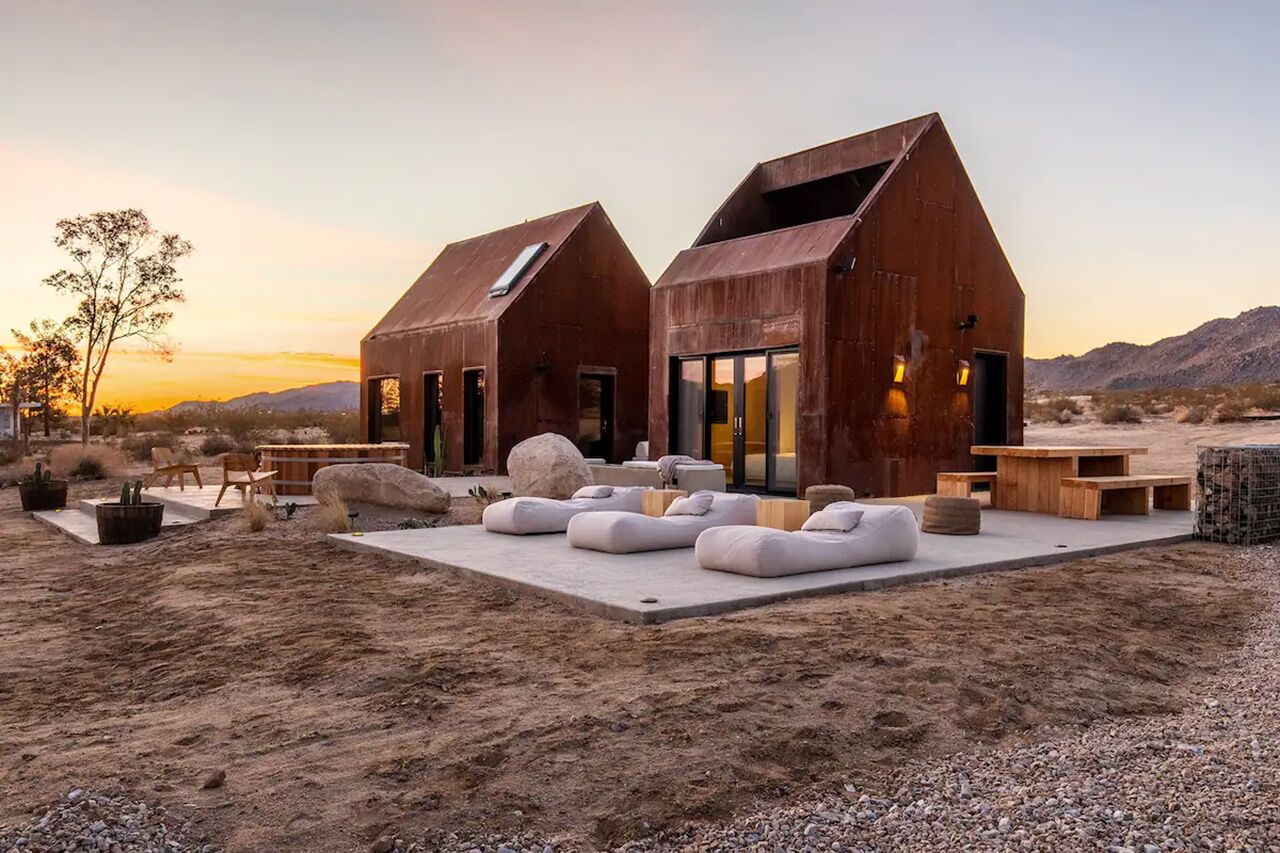
Photo: Airbnb
If you want to stay in hotels for your Joshua Tree trip, you’ll need to stay in Twentynine Palms or at a resort in Palm Springs (about an hour away). But if you don’t want to sleep outside, you’re way better off getting a cool desert Airbnb. Joshua Tree is known for having some of the coolest and hippiest home rentals in all of California — and many of them offer prime, remote locations for truly phenomenal stargazing.
For sleeping in and around Death Valley, you have more options. There are three hotels in the park. Panamint Springs Resort is probably the most basic option, with cabins and hotel rooms, plus campgrounds. There’s a basic on-site restaurant and a general store, and is the closest in-park option to Lone Pine, California, if you’re coming from Highway 395. Rooms are akin to fancy cabins at a KOA.
Stovepipe Wells Village is the midlevel option, with RV hookups, campsites, and motel-style rooms. Amenities include Wi-Fi, a year-round pool, and a cool Western-style saloon. The most luxurious hotel is the Oasis at Death Valley, with options for staying in a casita in a historic hotel (the Inn at Death Valley), or the newer and larger Ranch at Death Valley, which has more than 100 rooms, plus a golf course, Jeep rentals, and horseback rides from the hotel.
There are also a decent number of Airbnbs near Death Valley, though not as many as you’ll find around Joshua Tree.
Getting to Death Valley vs. Joshua Tree
Death Valley isn’t quite as day-trippable. The closest city is Las Vegas, which is only about a two-hour drive, but there are no big towns nearby, and the drive from Vegas is pretty barren. The closest towns to the west are in the remote parts of the eastern Sierra Nevada and are very small, like Lone Pine and Death Valley Junction. That said, they do have a few hotels and general stores, but not the amenities and tourism offerings of Palm Springs.
Neither Death Valley nor Joshua Tree have roads subject to seasonal closures, but they both are at risk from flooding and mudslides, so check the road conditions page for each park before planning your trip. Here’s the Joshua Tree conditions page, and here’s Death Valley. Very occasionally, some roads will close in Death Valley after heavy snow.
If you’re looking for a good week-long road trip, fly into Las Vegas and do a loop between Death Valley, Joshua Tree, and the Mojave National Preserve.
What kind of person will like each park?
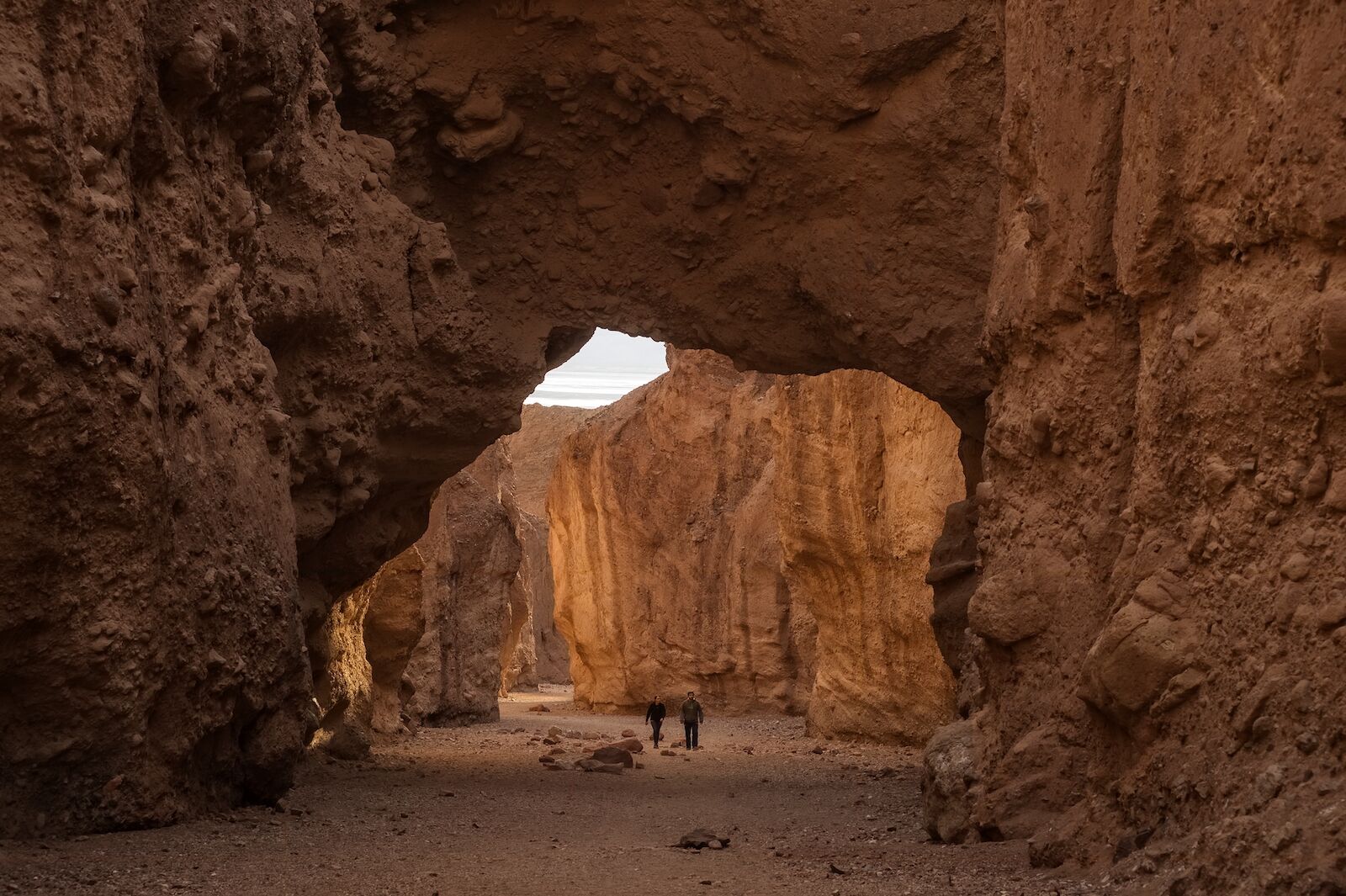
Hikers at a natural bridge in Death Valley National Park. Photo: NPS/Kurt Moses/Public Domain
Joshua Tree National Park has more hiking and climbing options, which tend to attract travelers looking for more guided, bookable, and hosted activity options. Joshua Tree also has more tourism companies in the vicinity thanks to Twentynine Palms and Palm Springs, plus more luxurious options for hotels and Airbnb rentals. It offers a bit more of a hip, artsy vibe, with glamping resorts and art galleries nearby. There are also far more beginner-friendly hiking trails.
Death Valley National Park may be a better option for travelers seeking to get away from people and civilization, or travelers who prefer a more rugged experience. The hikes are harder, the roads are rougher, and the landscapes are even more extreme. Death Valley also scores points for history buffs, with ghost towns, abandoned mines, and even an entire castle on the property grounds. And if you want to sleep in a national park, Death Valley is the only option.
Fortunately, photographers and stargazers will be happy at both parks, while hikers and backpackers will have more options at Joshua Tree — but also bigger crowds.